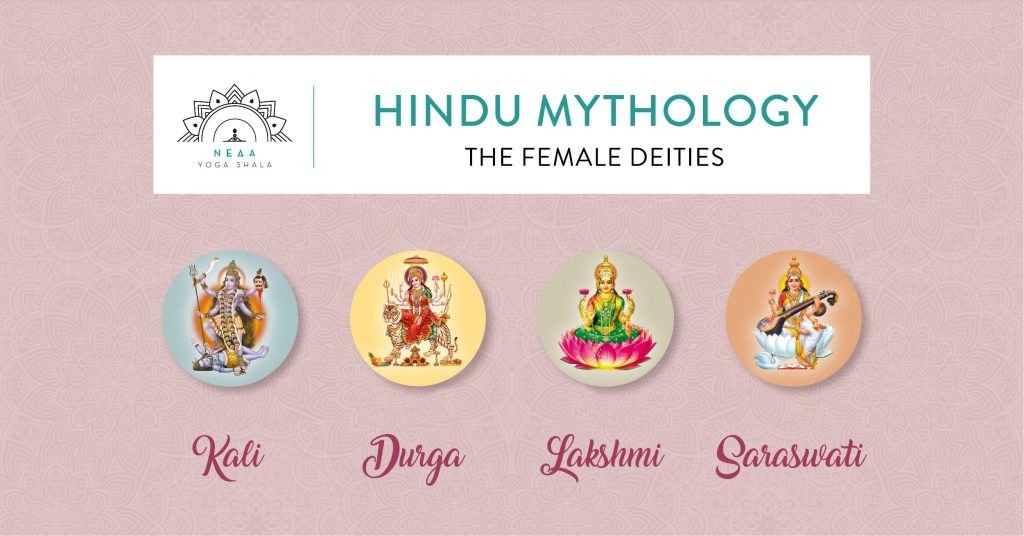
Hindu Mythology (Female Deities)
Woman... a creature full of grace and beauty, eroticism and innocence, warmth and compassion. Source of inspiration and evolution, embodiment of creativity, sacrifice and giving. Warrior and mother, full of power, mystery and love!
Indian mythology, with its deep wisdom and rich symbolism, recognises the sacredness of the feminine energy and gives it an equal - and often superior - role to the male deities. The goddesses of Indian mythology are not separate personalities but multifaceted expressions of the same Goddess (Devi). And each expression of the goddess is a fundamental principle that works in complementary ways with its partner and its energy is necessary to activate his functions.
For example, Saraswati, goddess of wisdom, music and speech, is not only the companion of Brahma but the very voice of creation. She appears from the exhalation of Brahma to provide knowledge and structure to the chaos. Without her, Brahma is unable to bring order; it is she who gives him the light of cognition to give birth to the world.
Lakshmi, goddess of abundance and beauty, embodies the heart of prosperity that sustains Vishnu's world. Whenever Vishnu descends to earth to restore the Dharma (cosmic order), Lakshmi follows him in forms like Sita or Rukmini, emphasizing how the auspiciousness of the feminine presence is essential even for divine missions.
Shiva, the Supreme Yogi, may in many traditions embody the supreme consciousness, but he is static and inert without his Shakti, his divine energy, which is embodied in various forms: Sati, Parvati, Durga, Kali. Shakti is not just his power - it is his active half, which awakens consciousness to express itself in the material world. When Parvati transforms into Durga, she becomes the warrior goddess who slays the demon Mahishasura that no god can face; a symbolic message that pure feminine power can crush any selfish or negative energy. As Kali, terrifying and powerful, she destroys everything in her wake. With her tongue sticking out, her black hair waving and her necklace of skulls, she represents the power of catalytic change that brings the deconstruction of the ego and liberation from illusions. She is not just a goddess of destruction; she is the liberator of souls, the energy that dissolves all that is false in order to reveal the Truth. As Sati, the goddess is a symbol of feminine devotion and sacrifice. Without her, Shiva becomes paralyzed and retreats to his cave in Mount Kailash.
Shaktism
There are traditions in Indian philosophy (e.g. Shaktism) where the Goddess - as a feminine divine principle - is placed above all, even male deities. Shaktism is one of the main streams of Hinduism, on a par with Vaishnavism (worship of Vishnu) and Shaivism (worship of Shiva). There, Shakti, the Absolute Feminine Energy, is considered the Ultimate Reality. In this approach, the Goddess as Adi Shakti, is not merely the creative energy of God, but the source of all phenomena itself, the Creator, Sustainer and Destroyer of the world. Male gods, such as Shiva, are considered passive or inactive without Shakti. They are “Shava” (corpse) without her - a popular pun in the tradition.
Here, Devi (Goddess) is worshipped in many forms (Durga, Kali, Tripura Sundari, Lalita, Bhagavati, Bhuvaneshwari, etc.) and is considered the Mother of the Universe (Jagadamba). Some of the key texts of Saktism are the Devi Mahatmya (part of the Markandeya Purana) and the Devi Bhagavata Purana, where the Goddess is presented as the beginning and end of everything, who creates the gods and worlds and possesses supreme power.
At the human level
Goddesses in Indian mythology are not just divine beings; they are symbolic embodiments of fundamental principles of nature, psyche and the universe as they are behind everything that manifests. They represent different aspects of the Divine Feminine Energy (Shakti) and at the same time archetypal models - mirrors of our own soul. The grace of Lakshmi, the wisdom of Saraswati, the power of Durga, the fiery anger of Kali, the devotion of Sati... All these qualities reside within us and together make up a complex but complete spiritual psychogram of man and existence. When approached not merely as mythical beings but as inner symbols, they can unfold deeply hidden aspects of ourselves and their study can be profoundly transformative.
The different aspects of the Goddess remind us that authentic power is not one-dimensional - it is multidimensional, colorful and multifaceted. That wisdom can coexist with anger, tenderness with violence, creation with repression. And even those aspects of ourselves that we often guilt us about are necessary and potentially sacred. Each of these qualities has its own role in our personal awakening and self-awareness.